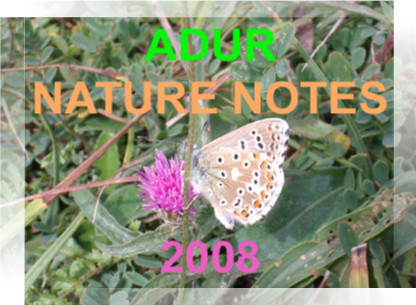
|
|
Seashore:
Southwick to Worthing, including Shoreham-by-Sea and Lancing
|

In the entrance
to Shoreham Harbour, there are artificial rocky*
shores at Kingston Beach near the Lighthouse,
and at the Old Fort beach on the other side of the
River
Adur. (* Larvikite,
a type of syenite). These new rock groynes have now been extended the full
length of Shoreham Beach and as far as Lancing Beach Green (May
2003).
12
May 2008
Even
more perfect conditions, a bit cooler and no breeze and only the occasional
rogue swell from a passing ship, my Brown
Shrimp, Crangon crangon,
haul at Southwick Beach was about two pints.
Other notable captures in the shrimp nets not recorded before this year
were one large fully grown 5-Bearded Rockling,
Ciliata mustela, (which
looked very much like a 3-Bearded Rockling, Gaidropsarus
vulgaris, until the beards were counted),
one juvenile Dragonet,
Callionymus
lyra,
a few very small swimming
crabs Portumnus
latipes, one South-clawed
Hermit Crab,
Diogenes pugilator,
in a Sting Winkle
shell, and a colourful Little Cuttle Sepiola.
Full
Report
BMLSS
Crabs of the Seashore
BMLSS
Shrimping
11
May 2008
Perfect
shrimping
conditions were encountered on the morning low tide at Southwick
Beach (1.2 metres
at 10:40 am)
on a sunny hazy day with an air temperature of 22.1
°C and a gentle swell. The haul included
plentiful Brown Shrimps, Crangon
crangon,
with all three shrimpers
getting more than enough for a meal each in under an hour, one fully grown
Lesser
Weever,
Echiichthys
vipera, and a few small ones, a few
small Solenettes
(Slipper
Soles),
Buglossidium
luteum, a few Vernal
Crabs, Liocarcinus
vernalis, one damaged (missing a claw)
Masked
Crab, Corystes cassivelaunus,
and
two green
Shore
Crabs, Carcinus maenas.
5 May
2008
On
Bank
Holiday Monday, it felt warm for the first
time this year as the temperature reached 20.0
°C at midday.
The wind was from the north, veering to the south-east and falling to Force
2 by the low spring tide.
Shoreham
Weather
My
first shrimping expedition
of the year at Lancing produced a moderate
amount of Brown Shrimps, Crangon
crangon, plus one Lesser
Weever, Echiichthys
vipera, one small Solenette
(Slipper
Sole),
Buglossidium
luteum, two
Vernal
Crabs, Liocarcinus
vernalis, and two South-clawed
Hermit Crabs,
Diogenes pugilator,
amongst more weed than is usual at the beginning of May.
4 February
2008
After
the recent storm there was a mass stranding
on Lancing Beach east at low tide.
I braved the chill westerly breeze and found the usual 'Mermaid's
Purses' Dogfish Eggcases
(including three with embryos seen inside), Ray
Eggcases, orange
and white sponges, Whelk
shells and eggcases Buccinum, and
also hundreds of dead sea
anemones, including dead and alive Snakelocks
Anemones, Anemonia
viridis. and larger Dahlia
Anemones, Urticina felina.
INTERTIDAL
WILDLIFE REPORTS
Link
to Intertidal 2007
Adur
World Oceans Day 2007
Rockpooling
Page
Zonation
on the Shore
Longshore
Drift
Longshore
drift occurs as a result of wave action. Propelled by the dominant
south-west winds1 the wave (the swash) hits the shingle beach and moves
the pebbles obliquely up the shore and the backwash returns the pebble
at right-angles, the following waves repeating the process so that the
pebbles gradually move along the shore. The larger pebbles are to be found
higher up the beach as the swash is more powerful than the backwash. On
Shoreham Beach the Environmental Agency interfere with the natural process
by moving large amounts of shingle back to where they were washed away
from, to protect the housing developments on the foreshore.
1The
prevailing winds over Britain are from the south-west. These propel the
waves on to the shore on both sides of the English Channel. However, on
other coasts the prevailing winds blow out to the sea and the dominant
waves that crash on to the shore come from other directions, e.g. from
the north-east on the North Sea coasts, causing longshore drift from north
to south.
|


